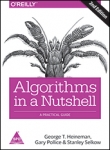|
|
| Book details / order |
| ALGORITHMS IN A NUTSHELL, 2ND EDITION |
Creating robust software requires the use of efficient algorithms, but programmers seldom think about them until a problem occurs. this updated edition of algorithms in a nutshell describes a large number of existing algorithms for solving a variety of problems, and helps you select and implement the right algorithm for your needs—with just enough math to let you understand and analyze algorithm performance.
with its focus on application, rather than theory, this book provides efficient code solutions in several programming languages that you can easily adapt to a specific project. each major algorithm is presented in the style of a design pattern that includes information to help you understand why and when the algorithm is appropriate.
with this book, you will:
solve a particular coding problem or improve on the performance of an existing solution
quickly locate algorithms that relate to the problems you want to solve, and determine why a particular algorithm is the right one to use
get algorithmic solutions in c, c++, java, and ruby with implementation tips
learn the expected performance of an algorithm, and the conditions it needs to perform at its best
discover the impact that similar design decisions have on different algorithms
learn advanced data structures to improve the efficiency of algorithms
about the author
george heineman is an associate professor of computer science at wpi. his research interests are in software engineering. he co-edited the 2001 book "component-based software engineering: putting the pieces together". he was the program chair for the 2005 international symposium on component-based software engineering.
gary pollice is a self-labeled curmudgeon (that's a crusty, ill- tempered, usually old man) who spent over 35 years in industry trying to figure out what he wanted to be when he grew up. even though he hasn't grown up yet, he did make the move in 2003 to the hallowed halls of academia where he has been corrupting the minds of the next generation of software developers with radical ideas like, "develop software for your customer, learn how to work as part of a team, design and code quality and elegance and correctness counts, and it's okay to be a nerd as long as you are a great one." gary is also a co-author of head first object-oriented analysis and design.gary is a professor of practice (meaning he had a real job before becoming a professor) at worcester polytechnic institute. he went to wpi because he was so impressed with the wpi graduates that he's worked with over the years. he lives in central massachusetts with his wife, vikki, and their two dogs, aloysius and ignatius. when not working on geeky things he ... well he's always working on geeky things. you can see what he's up to by visiting his wpi home page at http://web.cs.wpi.edu/~gpollice/. feel free to drop him a note and complain or cheer about the book.
stanley selkow received a bs in electrical engineering from carnegie institute of technology in 1965, and then a ph.d. in the same area from the university of pennsylvania in 1970. from 1968 to 1970 he was in the public health service at the national institutes of health at bethesda maryland. since 1970 he has been on the faculty at universities in knoxville tn and worcester ma, as well as montreal, chonqing, lausanne and paris. his major research has been in graph theory and algorithm design.
chapter 1. thinking in algorithms
understand the problem
naïve solution
intelligent approaches
summary
references
chapter 2. the mathematics of algorithms
size of a problem instance
rate of growth of functions
analysis in the best, average, and worst cases
performance families
benchmark operations
references
chapter 3. algorithm building blocks
algorithm template format
pseudocode template format
empirical evaluation format
floating-point computation
example algorithm
common approaches
references
chapter 4. sorting algorithms
terminology
representation
comparable elements
stable sorting
criteria for choosing a sorting algorithm
transposition sorting
selection sort
heap sort
partition-based sorting
sorting without comparisons
bucket sort
sorting with extra storage
string benchmark results
analysis techniques
references
chapter 5. searching
sequential search
binary search
hash-based search
bloom filter
binary search tree
references
chapter 6. graph algorithms
graphs
depth-first search
breadth-first search
single-source shortest path
dijkstra’s algorithm for dense graphs
comparing single-source shortest-path options
all-pairs shortest path
minimum spanning tree algorithms
final thoughts on graphs
references
chapter 7. path finding in ai
game trees
path-finding concepts
minimax
negmax
alphabeta
search trees
depth-first search
breadth-first search
a*search
comparing search-tree algorithms
references
chapter 8. network flow algorithms
network flow
maximum flow
bipartite matching
reflections on augmenting paths
minimum cost flow
transshipment
transportation
assignment
linear programming
references
chapter 9. computational geometry
classifying problems
convex hull
convex hull scan
computing line-segment intersections
linesweep
voronoi diagram
references
chapter 10. spatial tree structures
nearest neighbor queries
range queries
intersection queries
spatial tree structures
nearest neighbor queries
range query
quadtrees
r-trees
references
chapter 11. emerging algorithm categories
variations on a theme
approximation algorithms
parallel algorithms
probabilistic algorithms
references
chapter 12. epilogue: principles of algorithms
know your data
decompose a problem into smaller problems
choose the right data structure
make the space versus time trade-off
construct a search
reduce your problem to another problem
writing algorithms is hard—testing algorithms is harder
accept approximate solutions when possible
add parallelism to increase performance
appendix benchmarking
statistical foundation
example
reporting
precision
Author : Stanley selkow, george t. heineman, gary pollice
Publication : Oreilly
Isbn : 9789352133611
Store book number : 105
NRS 1200.00
|
 |
|

|
|
|
|
|
|
| |
|
|